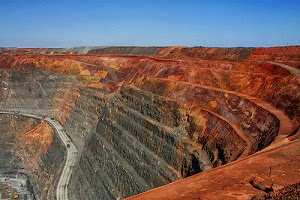
The world’s largest and oldest meteorite impact structure has been discovered through research on the formation of gold deposits in WA’s Eastern Goldfields.
Geologist Bob Watchorn says he has been analysing the structure using gravity and seismic databases since 1999 but has only recently discovered the prima facie evidence necessary to confirm its impact origin.
“I pinpointed where the rings should cut the roads … [and] you can see lines of hills heading perpendicular to the trend of hills in the eastern Yilgarn which is usually north-south,” he says.
“On the northern rings especially you can see large in situ shatter cones and striated rocks and various other prima facie evidence of a big impact.
“It was satisfying to find the prima facie evidence on the interpreted Landsat rings when I have had so many eminent geologists and geophysicists say that they couldn’t see any circular features.”
He says the link between mineral deposits and the rings of the WIS could impact mineral exploration in WA.
“I plotted all the gold and nickel mines [in the Eastern Goldfields] onto the Western Mining database,” he says.
“All of the big gold mines—I mean every single mine that was over one million ounces fell on the rings.
“If you’re going to go looking for deposits you should be looking in an entirely different location than what you would have before.”
He says careful analysis of the Yilgarn regional gravity data using small incremental changes to the sun angle dip and azimuth facilitated the discovery of the structure.
“I got the geophysicists to treat the databases in a very different way than what they normally treated it,” he says.
“I could see many concentric circular structures… at different levels of the lithosphere and then check them against seismic traverses that had been done.
“Eventually I was able to correlate different depth plans of the gravity data with the seismic data and noticed concentric bowl and dome shaped structures which correlated to the impact structures.”
He says the location of gold and nickel deposits on the rings are indicative of its significance to the makeup of the Eastern Goldfields.
“I know the gold deposits are 2.6 to 2.64 billion years old and they’ve actually formed on the rings,” he says.
“However the nickel formed 2.67 to 2.72 billion years ago and as most of the big nickel mines are on the rings there are still unanswered questions.
“It’s a paradigm-shifting discovery.”
Notes:
- The Vredefort Crater, in South Africa, was previously thought to be the largest known impact structure at 300km in diameter and just over 2 billion years old
- Shatter cones are rare geological structures known only to form beneath meteorite impact craters—they are evidence the rock has been subjected to significant pressure
- Lithosphere—refers to the earth’s crust and upper mantle









